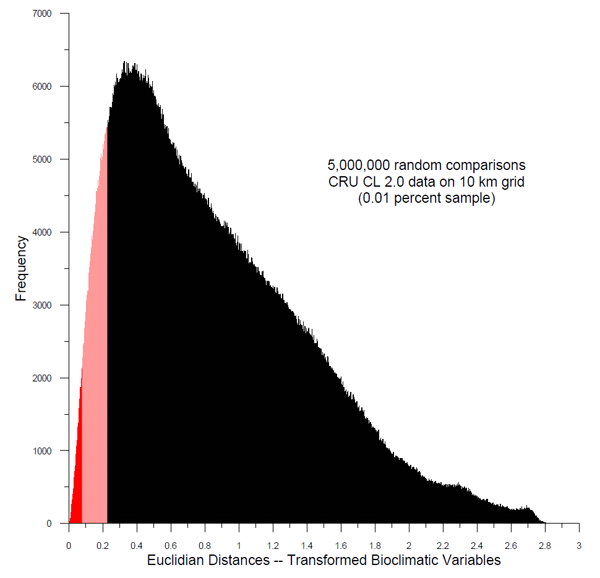Data
There are two basic data sets used in the analogue mapping—present
and future. The present climate is represented by the CRU CL
2.0 data set (Climate Research Unit, University of East Anglia
http://www.cru.uea.ac.uk/cru/data/hrg/).
These data consist of 1961-1990 long-term averages on a
10-min grid. The data
were regridded onto a 10-km grid (Lambert Azimuthal Equal-Area
projection, centered at 100E and 50N) coregistered with the USGS
Seasonal Land Cover 1-km data set for North America.
The interpolation was done via locally weighted trend-surface
regression, with elevation as a covariate (thereby producing a
topographically corrected interpolated values).
There are 218,882 non-ice-covered grid cells for North
America.
Average monthly temperature and precipitation were used in the
analogue calculations, and, along with monthly percent-possible
sunshine, were also used to create a set of 40 “bioclimatic”
variables (e.g. growing degree-days, the Priestley-Taylor moisture
index "alpha" (the ratio of actual equilibrium evapotranspiration to
potential equilibrium evapotranspiration or AE/PE), etc.) using the
Cramer-Prentice approach for the moisture-balance calculations.
Future climates are represented by the WCRP CMIP-3 climate
simulations done as part of the IPCC Fourth Assessment (http://www-pcmdi.llnl.gov/ipcc/about_ipcc.php) For this
demonstration, output was used from two models, the NCAR Community
Climate System Model 3 (CCSM3) and UK Met Office Hadley Center
Climate Model 3 (HadCM3) for the SRES A2 emissions scenarios.
Simulated “anomalies,” or the differences between the
1961-1990 “20th-century control” simulation averages and decadal
averages for two 21st-century intervals (2040-2049 and 2090-2099)
were calculated over each model’s “native” grid. These
anomalies were then
interpolated onto the North American 10-km grid, and added to the regridded CRU CL 2.0 long-term averages.
This procedure produces 10-km data sets for the middle and
end of the 21-st century for each emissions scenario/climate model
combination.
Bioclimatic variables for the future climate data sets were obtained
in the same fashion as for the “present” climate data set.
Climate simulations for other SRES emissions scenarios will
be included later.
The climate data were stored as netCDF files (http://www.unidata.ucar.edu/software/netcdf/), which can be opened and displayed using Panoply (http://www.giss.nasa.gov/tools/panoply/
). A single monthly
temperature or precipitation netCDF file is 62 Mbytes, while one
containing the values for 40 bioclimatic variables is 173 Mbytes.
Analogue Calculations
Analogues are displayed here using statistical distance or dissimilarity
measures, where low distances or dissimilarities indicate similar or
analogous climates. For each
particular target point, four sets of analogues were obtained for each
combination of climate scenario (and time) and choice of
analogue-calculation parameters (see below):
1) “present vs. future”
analogues that show the dissimilarity between the present climate at a
target point and the future climates over the “field” of grid points;
these show where the present climate of the target point will occur in
the future; 2) “future vs. present” analogues that show the
dissimilarity between the future climate at a target point and the
present climate over the field of grid points; these show where the
future climate at the target point occurs at present; 3) “present vs.
present” analogues that show the locations with present-day climates
similar to those at the target point; and 4) “future vs. future”
analogues that show the same thing under a particular future climate
scenario. These last two
analogue patterns describe how unique or common the climate at a target
point is at present, and how that pattern may change in the future.
Each set of four dissimilarity-value maps were also stored as
netCDF files, about 31 Mbytes in size.
Analogue Bases
The calculation of dissimilarities between climates at different
locations or times requires the specification of a particular set of
climate variables to use. Analogues
could be expressed, for example, in terms of temperature alone, moisture
alone, temperature and moisture, and so on, where the specific set of
variables used is referred to here as an “analogue basis.” Six analogue bases are used here:
|
Name |
Abbreviation |
Variables |
|
Temperature |
tmp |
TJan, TFeb, … TDec |
|
Precipitation |
pre |
PJan, PFeb, … PDec |
|
Temperature + Precipitation |
tmp + pre |
TJan, … TDec, PJan, …, PDec |
|
Bioclimatic variables |
bioclim |
GDD5, AE/PE, MTCO, MTWA, Chill |
|
Moisture seasonality |
seas moist |
MAM, JJA, SON, and DJF AE/PE, PJan/PAnn, PJul/PAnn and PJan/PJul |
|
Temperature seasonality |
seas tmp |
TAnn, TJan, TApr, TJul, TOct |
Transformation of Variables
The individual climate variables
have several different of kinds distributions, ranging from those that
are nearly normal (e.g. temperature variables) to those that are
positively skewed (long right tail, e.g. precipitation), to those with
unusually shaped distributions (e.g. AE/PE, which is negatively skewed,
i.e., with a long left tail).
Skewness influences the calculation of analogues by giving
observations in the tails of skewed distributions disproportionally large
(e.g. in the case of the upper tail of positively skewed distributions) contributions to the
dissimilarity values, and those in the opposite tail disproportionally
small contributions.
Individual dissimilarity values may therefore be influenced more by
where an observation of a particular climate variable falls under its
distribution than by practical differences in the climates of two
locations.
Consequently, the Box-Cox
transformation, a variance-stabilizing power transformation, was used to
transform the individual variables.
The transformation parameter, lambda, was estimated by maximum
likelihood for each variable; this has the practical interpretation of
attempting to transform the distribution of each variable toward the
normal distribution. Lambda
values of 1.0 involve no transformation, 0.5 and 0.3333
amount to the square-root and
cube-root transformation, and a value of 0.0 essentially gives the
logarithmic transformation.
Negatively skewed distributions, like those of AE/PE, are transformed
toward the normal by lambda values > 1.0.
As is common practice, we adopted easily interpretable values,
like 0.5 or 0.3333, in effect “rounding” the maximum likelihood values.
The histogram on the left below
shows the distribution of January precipitation, while that on the right
shows that for transformed January precipitation with lambda = 0.3333,
(i.e. the commonly used “cube-root” transformation for precipitation).
For comparison, analogues were also calculated using
untransformed variables.
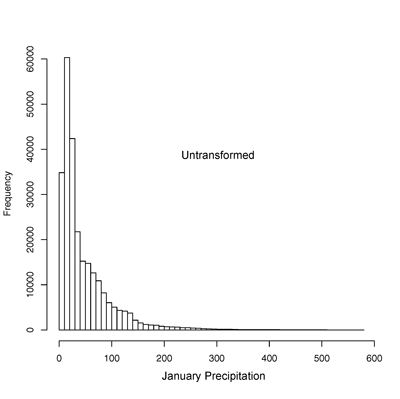
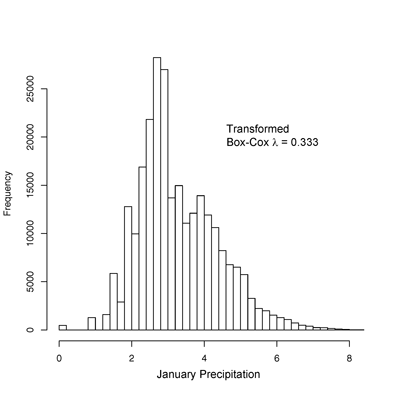
Dissimilarity Measures
Two dissimilarity measures were
used in this demonstration:
1) the widely used Euclidian-distance measure, and 2) the Mahalanobis
distance, a statistical distance measure that takes into account the
covariance among the variables.
Many of the variables (e.g. the monthly temperature variables, or
GDD5 and MTWA), are highly correlated, and in a sense contribute
redundant information to dissimilarity measures like the Euclidian
distance. The Mahalanobis
distance can be thought of as an Euclidian-distance like measure, where
the contributions of the individual variables to the distance are
weighted by the elements of the inverse of the covariance matrix.
The scatterplot on the left below shows the values of January and
July temperature, with the Euclidian distance between each point and the
centroid of the two variables indicated by the size of circle
representing each point, while the scatterplot on the right shows the
same thing for the Mahalanobis distances.
(Note; the obvious moiré
pattern on the scatterplot on the left is created by the
rasterization of the image.) The Mahalanobis distances can be thought of
as the distance to the centroid measured across the isoprobability
contours of a bivariate normal distribution fit to the data (shown in
red). Other dissimilarity
measures could also be considered, like the Minkowski, or city-block
distance.
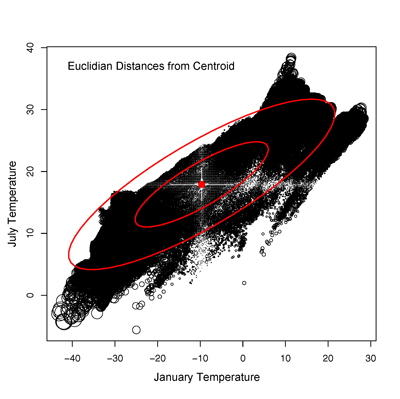
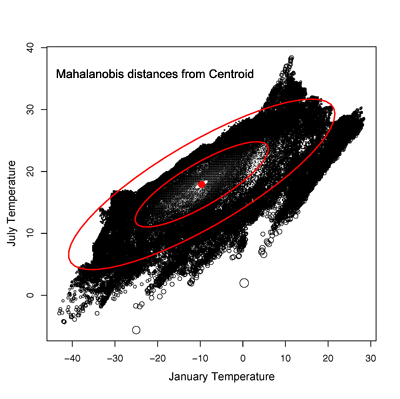
Analogue Maps
An important issue is determining
what constitutes an “analogue.”
One way of skirting this issue is to plot the analogues
(dissimilarity values) on a continuous scale, but this would still
require a user to choose some kind of intuitive threshold value to avoid
distraction by low-analogue medium-dissimilarity value points.
The alternative of adopting some kind of single-value threshold
is also unsatisfactory, because information on potential gradients in
dissimilarities will be lost.
For this demonstration, a strict a and more liberal threshold was
used in creating the maps.
The distribution of dissimilarity values created by comparing
present-day observed (CRU) climate at each
point with those of all of the other points was estimated by 5 million
random comparisons between the climate values at individual points (there are 48 x 10^9 total potential comparisons) for
each analogue basis and transformation selection. The 1st
and 5th percentile values were selected as indicators of strong and
weak (or less-strong) analogues.
The histogram below shows the random comparisons within the CRU
10-km data set for a set of bioclimatic variables (i.e. analogue-basis
4), with the 1st
and 5th percentile values shaded as dark and light red, respectively.
These values were used in creating the analogue maps.
